
Hello and welcome back to Sunday Soliloquies, with your host, Miss Nathalie Moreno. *canned applause*
Lately I’ve been thinking about Club Pink Pussycat, my very favorite building in all of Miami. Seeing this building, or the image of it I use as my desktop wallpaper, brings me the equivalent emotions of closing my eyes on a sunny day and watching the colorful blobs that form on the screen of my eyelids. In today’s letter, I talk about this building but mostly about it’s place in the great city I love.
Now for the letter:
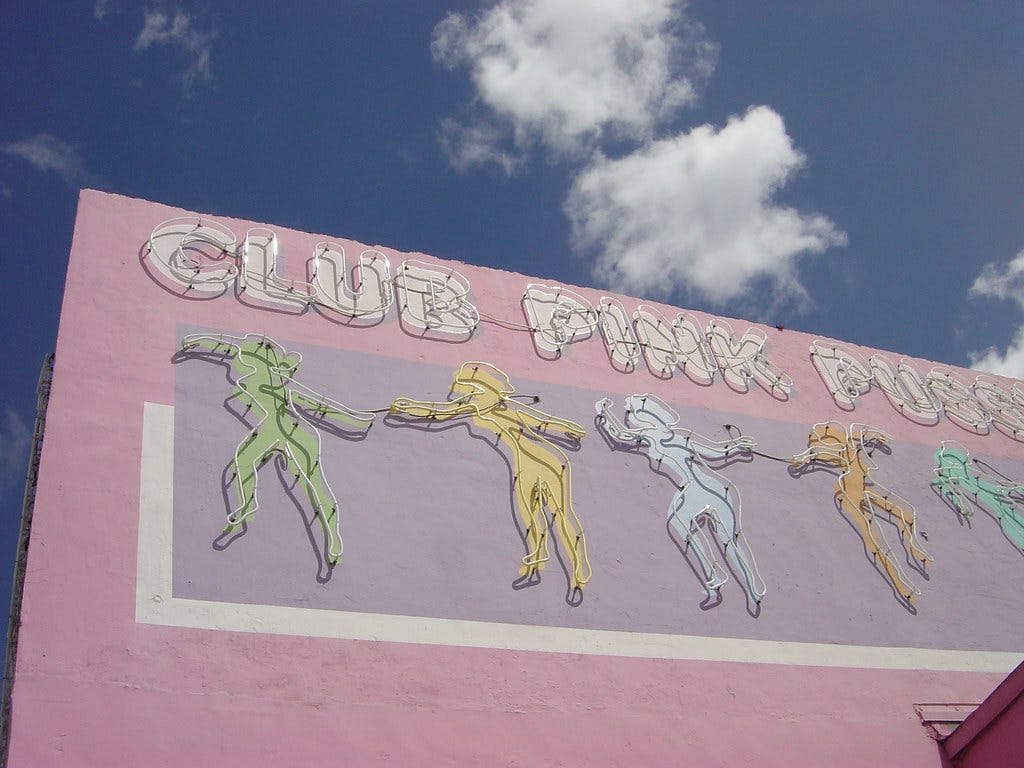
*chefs kiss*
I do not care to admit the amount of times that I have attempted to photograph Club Pink Pussycat while sitting at a red light behind an 18-wheeler or two, or even more precariously, while driving away from it. These countless attempts have been futile as all of the images I have of the club are blurry or under-exposed, almost as if the ephemeral nature of the building refuses to let itself be collected.
Of course, I don’t remember the first time I saw this enormous pink block of a building but I do remember sitting in the back seat of my mother’s Maxima, watching it go by, thinking it was the most beautiful sight I’d ever seen. And though I had inklings about what this structure housed, I never cared too much for its insides. I believed then, and still do today, that the magic of this cube would disappear if something in its interior did not align with my expectations of it.
According to the Sun Sentinel, during its “heyday in the 1970s and ‘80s,” Club Pink Pussycat, which opened in 1925 gained a bad reputation “as a sleazy haven for drug trafficking, prostitution, and money laundering with its fair share of (allegedly) nefarious owners like the Columbo mafia family”. I’ve noticed in my research, that when historians and journalists talk about Miami in the ‘80s, they start with the bad and sometimes wrap up with the good.
Important Events in 80s Miami, Bad and Good Mixed Up:
1. Mariel Boatlift that unexpectedly brought over 125,000 Cuban refugees onto South Florida’s shores.
2. Brian DePalma’s Scarface
3. Miami Vice
4. The Cocaine Cowboy Era, a time defined by drug wars between drug cartels and the U.S. government.
5. 40,000 Haitian immigrants were granted political asylum in Miami, adding to the 200,000 that arrived in the 1970s and created Little Haiti.
6. Arquitectonica designed Brickell’s skyline, creating a sleight of new high rise buildings in a formerly residential neighborhood, creating what is now a major part of Downtown Miami.
7. Miami Cultural Center Opens, now the Miami Public Library Main Branch. I can confirm that this building is beautiful and has a first floor rotunda that contains a panoramic Ed Ruscha text work!
8. Arthur McDuffie, a black insurance salesman and veteran, was murdered by four Miami-Dade County officers in 1979. The four officers were charged and later acquitted, leading to uprisings in Miami’s Liberty City and Overtown. 18 people lost their lives during the protests which also resulted in over $100 million in property damage in three days. What is now called the “Miami Riots” were considered the largest uprising since the Civil Rights era until the Los Angeles Riots in 1992.
9. Surrounded Islands by Christo and Jeanne-Claude
As much I love the Club Pink Pussycat building, I don’t think that it’s actually what’s important about this tiny corner of Miami, the same intersection that separates Hialeah, a majority Latinx city of Miami-Dade County, from a cluster of majority Black neighborhoods. If anything, this building has been a witness to the beauties and atrocities that have created the city we know today. But I want to focus on two very specific demographics within the county, which also happen to the most similar and differentially treated: Haitian-Americans and Cuban-Americans.
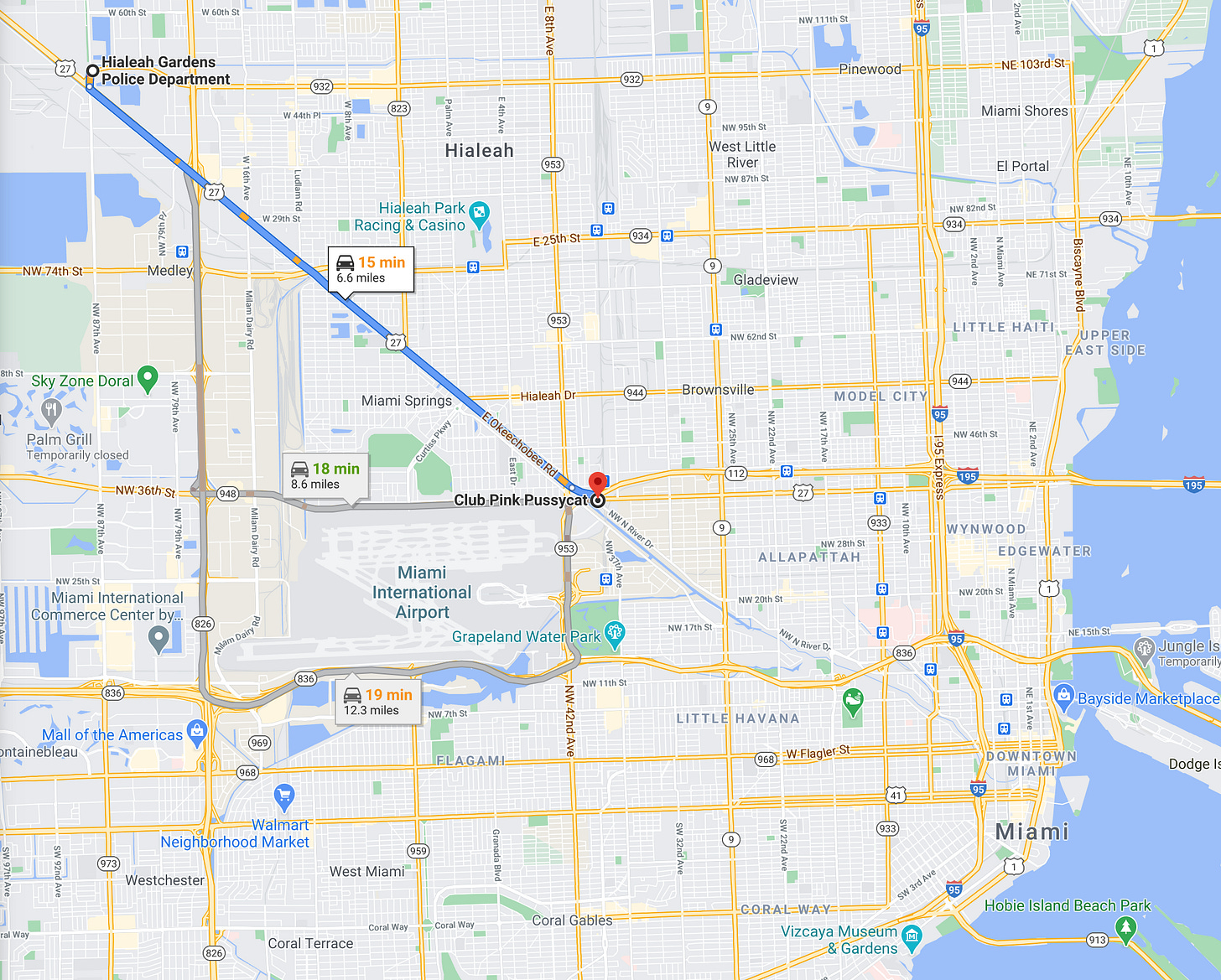
a map of Miami-Dade County that tracks the route from Hialeah to Club Pink Pussycat. Courtesy of Google Maps.
A Quick History Lesson
After the Cuban Revolution, specifically after Fidel Castro took authoritarian hold of Cuba’s government in 1959, people began immigrating from the island into Miami in unending waves, usually settling in Little Havana or Hialeah. Mostly, people came over in the tens of thousands per year except during the Mariel boatlift, during which over 120,000 Cubans emigrated to Miami after Fidel Castro stated that anyone who wanted to leave could do so. In the 90s, due to continued scarcity in food, money, water, and electricity tens of thousands of exiles, or balseros, left in homemade balsas, or rafts, making up what is known as the Rafter Crisis. Though many exiles who came over during these two specific waves were held in refugee camps in Miami or Guantanamo Bay, and some were even sent to federal prison as they awaited deportation hearings, for the most part, the Cuban population was treated with benevolence. Cubans were given federal fiscal aid, an easy path to residency and citizenship due to Wet Food/Dry Foot — a policy, that existed until the Obama administration, that allowed all Cubans who stepped on U.S. soil to legally stay in the country — and an annual allotment of 20,000 visas. Though they faced an English only movement in Miami as they began settling, Cubans quickly became a cultural and political power in Miami and the federal government.
Let us compare this to Haitian migration to Miami.
Haitian migrants arrived in Miami as early as 1963. But it wasn’t until the 1970s when Jean-Claude “Baby Doc” Duvalier’s dictatorship came around, that larger groups of Haitians began traveling the astonishingly dangerous 700 miles to Miami. Over 240,000 exiles arrived in South Florida during Duvalier’s reign, which lasted from 1971 to 1986. From then on, people seeking asylum and better lives away from poverty, political conflicts, and corruption, have been fleeing in rates similar to Cubans, in the tens of thousands each year. Like the Cuban balseros I mentioned earlier, Haitians have been risking their lives, often in inadequate boats or rafts to the U.S. and have become one of the largest demographic groups in Miami, second only to Cubans.
But these similarities were not enough to bridge the one major difference between these two immigrant groups: race. Because Cuba has a history of systemic racism and because Cubans migrated chronologically in terms of class, beginning with upper class, followed by middle and working class, many of the early waves of movement consisted of mostly white or white-passing people. It is this proximity to whiteness that has allowed Cubans to dominate Miami’s economy and government for so long. Most Haitians, though they qualify for asylum in the U.S., are not granted this simple title that most Cubans are given, leaving about half of all Miami Haitians without U.S. citizenship. Because Haitians are viewed as persons fleeing “economic distress” they are faced with detainment or repatriation upon arrival on South Florida’s shores.
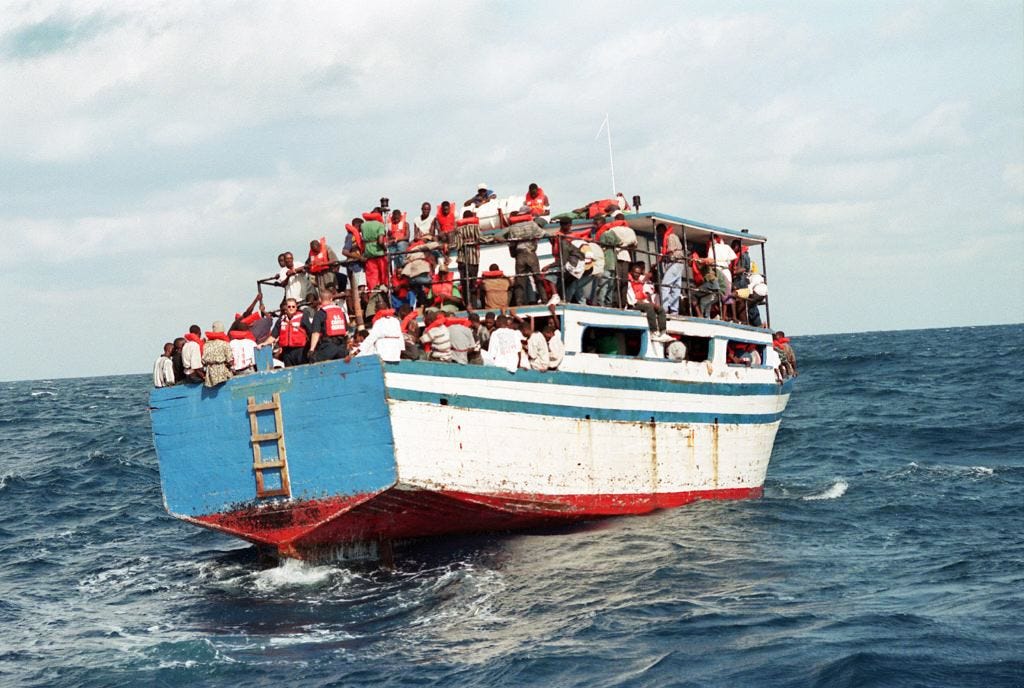
A boat with over 100 Haitians aboard near the Port of Miami, circa 1990 - 1999. (US Coast Guard/AFP/Getty Images)
In 2002, PBS held a conversation with experts called Handling Haitian Refugees, during which Gwen Ifill stated that “U.S. immigration policy has special rules when it comes to Haiti. Mexicans, Cubans, and others, all are treated differently”.
In response, Jan Ting, a law professor at Temple University, said:
”Well, the Cubans have always been a special case and I think there is two reasons for that. First of all, our policy towards Cuba is a vestige of the Cold War…and then thanks to the Cuban Adjustment Act of 1966 they can adjust status to legal permanent residents after one year. And that policy has kind of been maintained up to the present day in part for I think for political reasons; that Florida is the key swing state as everyone knows and the Cuban-American vote in Florida is the swing vote in a swing state”.
Ting’s statement makes it very clear that the U.S. allows itself to treat immigrants groups selectively according to how much they can offer or hinder the federal government. But, if Haitians were treated justly, they would have been supported in facing a Miami that views them as minorities for their language, Blackness, and immigration status.
Miami-Dade and Club Pink Pussycat Today
To be honest, I’m not sure how Club Pink Pussycat fits into all this. Like many of the buildings in Miami, and systems, it has simply stood in the face of racial injustice and the discrimination that has caused Miami to be a city that puts money first and its people second. But I know that to drive past my most favorite pink building into and through a delineated Black neighborhood is not enough. Whether in this city or another, we must actively support and engage in the businesses that will help these communities thrive. It is painful to think of the shame and precarity that Haitian-Americans have faced on their journey away from abject poverty in their homeland and into the racist, poor, and neglected neighborhoods that they have filled with their beautiful foods and rich art in Miami. Reparations must be made until Haiti’s flag flies freely throughout Miami and the community has the economic and political power that they deserve. A small step we can make it donating to organizations like Sant La Haitian Neighborhood Center or by learning about Haitian culture and dining at some of the gastronomical treasures they have added to Dade County’s landscape.

We’re gonna stay in the theme of pink and celebrate one of my favorite works of art of all time, Surrounded Islands.
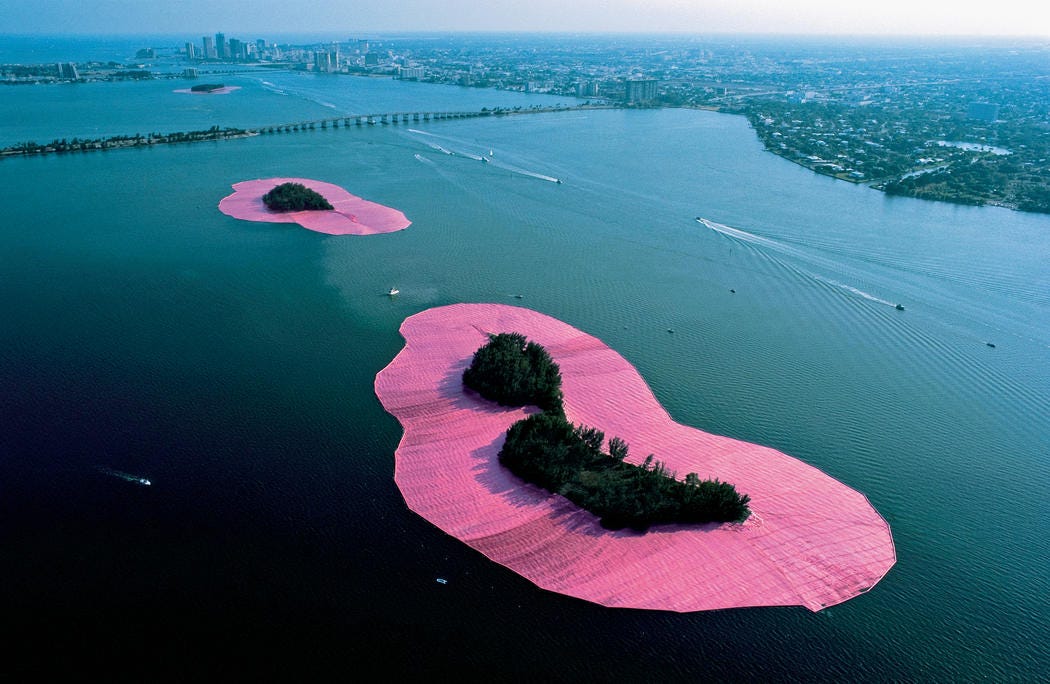
Surrounded Islands by Christo and Jeanne-Claude.

13 Things I’ve Consumed This Week:
1. Diana: In Her Own Words, a documentary on Netflix. It gave me a much deeper understanding of Princess Di than I thought I would get, in it there are conversations that she had recorded in secret for her tell-all book. The fact that she became royalty at the tender age of 19 and had no one to guide her transition or console her painful marriage is really incredible to me. I understand why she’s so beloved.
2. Many images of elephant figurines, originally my search was research for a painting but I got lost in the cuteness. My favorite results came from googling “elephant figurines wood set”. See below.
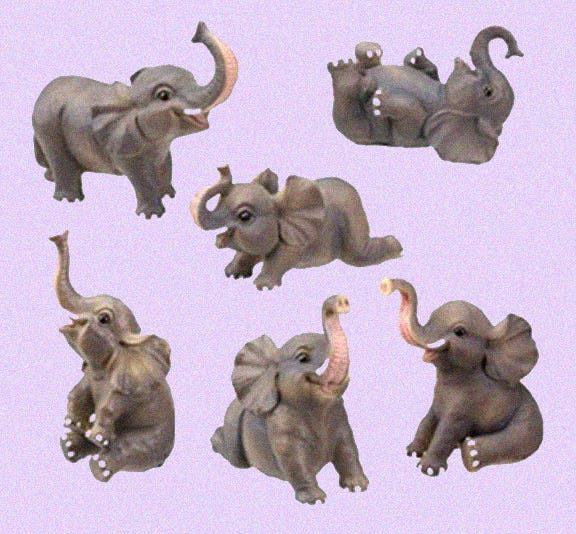
3. Too many halves of homemade macarons. After four (failed) attempts and an injured toe, Anniel has given up.
4. I May Destroy You. I already know that I’m the last person to watch this so I’ll just say that Michaela Cole can communicate things I didn’t know were possible to express.
5. I have not personally been consuming the new Greenies Tuna Flavor snacks but I can attest, Cheddar is a fan.
6. The work of Theresa Chromati.
7. This Glossier hoodie that I look at lovingly. I mostly love that Timothée Chalamet is the reason why everyone is buying this.
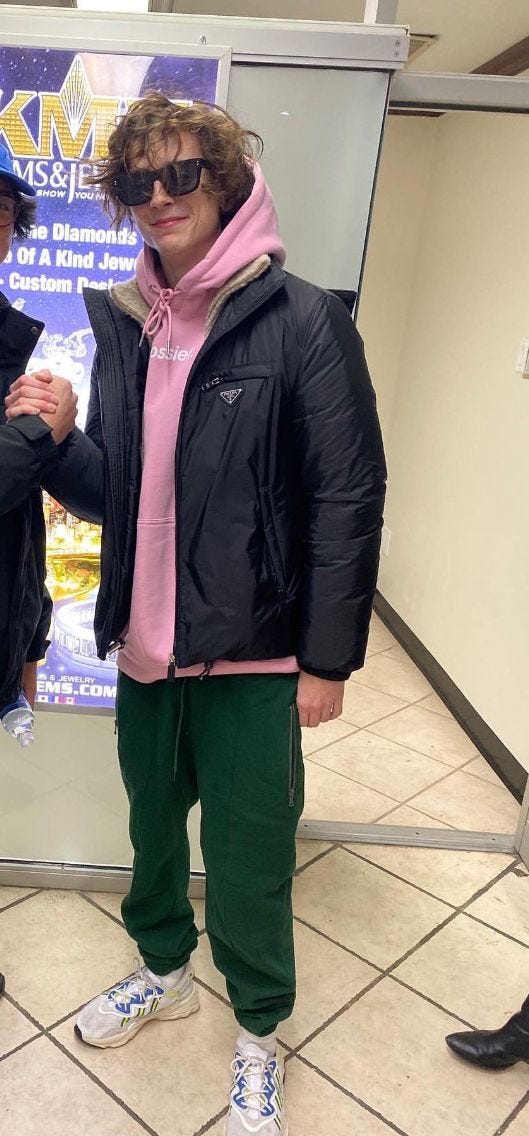
8. This poem by Nicole Sealey that is in the current issue of The Paris Review.
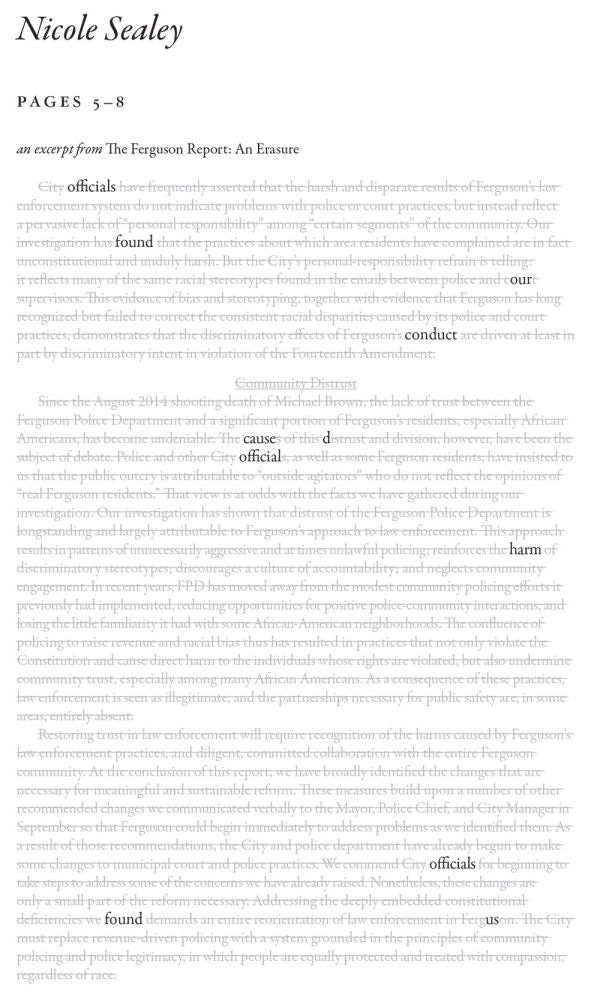
9.Cocokind daily SPF. If you are looking for a daily sunscreen that won’t leave your skin looking white and greasy, this is the one. It also uses zinc oxide which literally sits atop your skin to block UVA and UVB rays.
10. Transcedent Kingdom by Yaa Gyasi. I’m tackling my to-do list furiously so I can go back to it.
11. Sister Sister is on Netflix and I’m rewatching and so comforted, it’s equivalent to a mug of warm chocolate milk.
12. Jessica Krug’s article, “The Truth, and the Anti-Black Violence of My Lies”. In it she reveals that she is a white Jewish woman who has based her academic career on the lie that she is a black woman. She first assumed North African Blackness, then US rooted Blackness, then Caribbean rooted Bronx Blackness, which led her to claim an Afro-Latinx identity. What is most disturbing about the Jessica Krug is the fact that she was a professor at George Washington University and a published author who wrote on Blackness. So, how many Black students and faculty members did she hurt with her lies and jealousy? How many Black people lost opportunities that she took up so pathetically?
13. @ktowncornerstore tiled-cube side tables! I wish I had one, for now I will manifest.
It’s our month-aversary and I appreciate each and every one of you reading!
Love,
Nathalie





